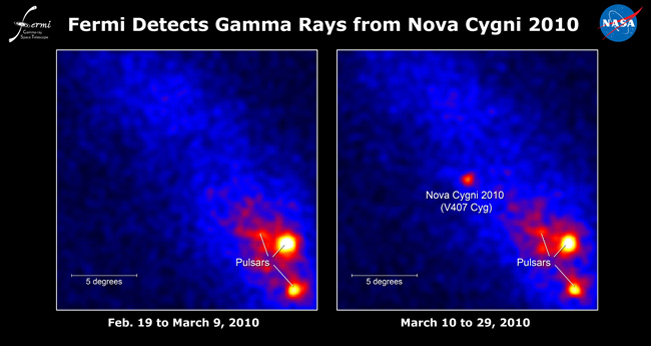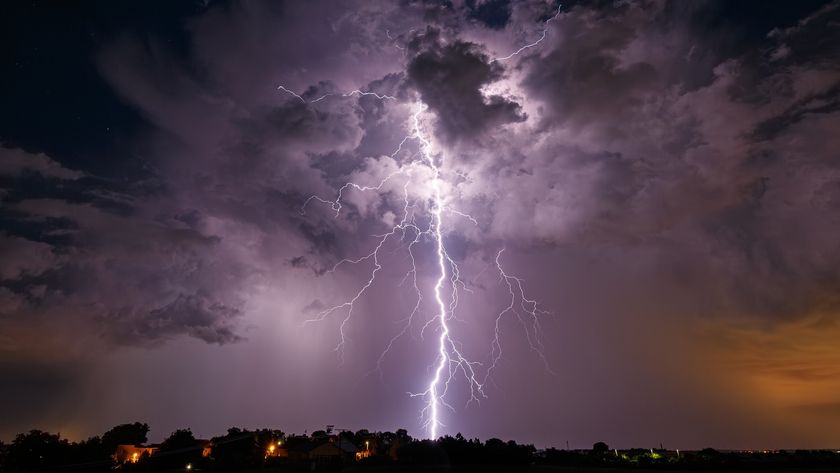New Kind of Star Explosion Discovered

Anunexpected and powerful new kind of star explosion has been discoveredin theheavens ? a so-called gamma-ray nova that radiates the most energeticform oflight in the universe.
Anova is a massive thermonuclear explosion from a whitedwarf star fueled by mass from a companion star. Unlike supernovas,novasdo not result in the destruction of their stars. Researchers hadexpected andseen X-rays from the resulting waves of expanding gas in prior novas.Butunlike with supernovas, they had not seen gamma-rays emitted by novas.
Nowresearchers have discovered a nova that shed gamma rays, which are evenmore powerfulthan X-rays, by using the Fermi Large Area Telescope in orbit aroundthe Earth,the most sensitive gamma-ray space telescope ever flown. [Photoof thegamma-ray nova.]
"Thisis the first gamma-ray nova seen," said researcher Teddy Cheung, anastrophysicist at the Naval Research Laboratory in Washington.
Gamma-raystar explosion
Thegamma rays in question emerged from the binary system known as V407Cygni some8,800 light-years away, which consists of a white dwarf and a pulsatingredgiant star. They came after a nova spotted by amateurJapanese astronomersin March, which at its peak was just below the level of naked-eyevisibility,brighter than at any other point in the nearly 75 years scientists hadwatchedthe system.
Theresearchers suggest the gamma rays were generated when the blast wavesfrom thenova collided with the very dense winds from the red giant.
Get the Space.com Newsletter
Breaking space news, the latest updates on rocket launches, skywatching events and more!
"Asthe blast wave propagates outward, it acts like a snowplow, sweeping upmaterial from the stellar wind, and a shock front forms," explainedresearcherAdam Hill, an astrophysicist at the University of JosephFourier-Grenoble inFrance.
Protonsand electrons get accelerated to very high energies at this shockfront. Inturn, they produce gamma rays.
Anexpected find
Inmany novas, the white dwarf's companion is a normal main sequence star,and assuch has a much less dense stellar wind compared to the red giant inV407Cygni, for less material to generate gamma rays with. Very few binarysystemsare expected to combine the kind of whitedwarf stars that burst with novas with red giant companions,and as suchthe researchers expect gamma-ray novae to be quite rare.
"Itis always exciting to discover something new and unanticipated," Hillsaid. "It is occasions such as this which is why I enjoy being ascientist."
Theresearchers at the Fermi-LAT Collaboration detailed their findings intheAugust 13 issue of the journal Science.
- Top10 Star Mysteries
- TheStrangest Things in Space
- AstronomersHunt for Ticking Time Bombs
Join our Space Forums to keep talking space on the latest missions, night sky and more! And if you have a news tip, correction or comment, let us know at: community@space.com.

Charles Q. Choi is a contributing writer for Space.com and Live Science. He covers all things human origins and astronomy as well as physics, animals and general science topics. Charles has a Master of Arts degree from the University of Missouri-Columbia, School of Journalism and a Bachelor of Arts degree from the University of South Florida. Charles has visited every continent on Earth, drinking rancid yak butter tea in Lhasa, snorkeling with sea lions in the Galapagos and even climbing an iceberg in Antarctica. Visit him at http://www.sciwriter.us











